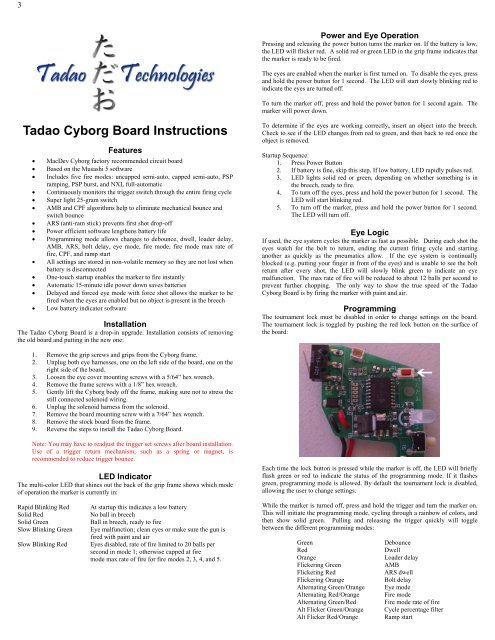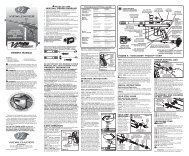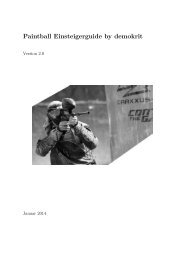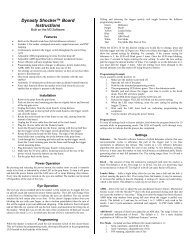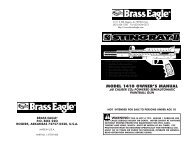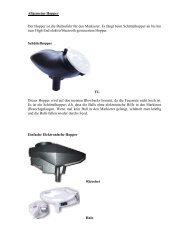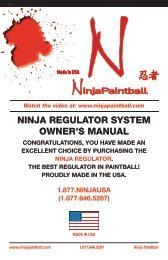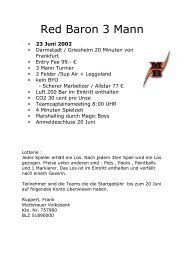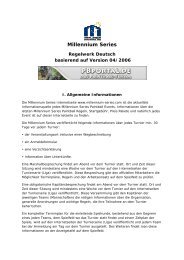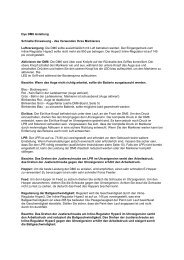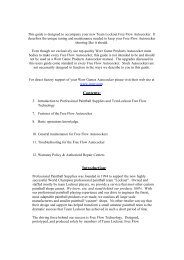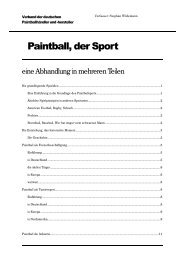Tadao M5 Cyborg manual - Tadao Technologies
Tadao M5 Cyborg manual - Tadao Technologies
Tadao M5 Cyborg manual - Tadao Technologies
You also want an ePaper? Increase the reach of your titles
YUMPU automatically turns print PDFs into web optimized ePapers that Google loves.
3<br />
Power and Eye Operation<br />
Pressing and releasing the power button turns the marker on. If the battery is low,<br />
the LED will flicker red. A solid red or green LED in the grip frame indicates that<br />
the marker is ready to be fired.<br />
The eyes are enabled when the marker is first turned on. To disable the eyes, press<br />
and hold the power button for 1 second. The LED will start slowly blinking red to<br />
indicate the eyes are turned off.<br />
To turn the marker off, press and hold the power button for 1 second again. The<br />
marker will power down.<br />
<strong>Tadao</strong> <strong>Cyborg</strong> Board Instructions<br />
Features<br />
• MacDev <strong>Cyborg</strong> factory recommended circuit board<br />
• Based on the Musashi 5 software<br />
• Includes five fire modes: uncapped semi-auto, capped semi-auto, PSP<br />
ramping, PSP burst, and NXL full-automatic<br />
• Continuously monitors the trigger switch through the entire firing cycle<br />
• Super light 25-gram switch<br />
• AMB and CPF algorithms help to eliminate mechanical bounce and<br />
switch bounce<br />
• ARS (anti-ram stick) prevents first shot drop-off<br />
• Power efficient software lengthens battery life<br />
• Programming mode allows changes to debounce, dwell, loader delay,<br />
AMB, ARS, bolt delay, eye mode, fire mode, fire mode max rate of<br />
fire, CPF, and ramp start<br />
• All settings are stored in non-volatile memory so they are not lost when<br />
battery is disconnected<br />
• One-touch startup enables the marker to fire instantly<br />
• Automatic 15-minute idle power down saves batteries<br />
• Delayed and forced eye mode with force shot allows the marker to be<br />
fired when the eyes are enabled but no object is present in the breech<br />
• Low battery indicator software<br />
Installation<br />
The <strong>Tadao</strong> <strong>Cyborg</strong> Board is a drop-in upgrade. Installation consists of removing<br />
the old board and putting in the new one:<br />
To determine if the eyes are working correctly, insert an object into the breech.<br />
Check to see if the LED changes from red to green, and then back to red once the<br />
object is removed.<br />
Startup Sequence:<br />
1. Press Power Button<br />
2. If battery is fine, skip this step. If low battery, LED rapidly pulses red.<br />
3. LED lights solid red or green, depending on whether something is in<br />
the breech, ready to fire.<br />
4. To turn off the eyes, press and hold the power button for 1 second. The<br />
LED will start blinking red.<br />
5. To turn off the marker, press and hold the power button for 1 second.<br />
The LED will turn off.<br />
Eye Logic<br />
If used, the eye system cycles the marker as fast as possible. During each shot the<br />
eyes watch for the bolt to return, ending the current firing cycle and starting<br />
another as quickly as the pneumatics allow. If the eye system is continually<br />
blocked (e.g. putting your finger in front of the eyes) and is unable to see the bolt<br />
return after every shot, the LED will slowly blink green to indicate an eye<br />
malfunction. The max rate of fire will be reduced to about 12 balls per second to<br />
prevent further chopping. The only way to show the true speed of the <strong>Tadao</strong><br />
<strong>Cyborg</strong> Board is by firing the marker with paint and air.<br />
Programming<br />
The tournament lock must be disabled in order to change settings on the board.<br />
The tournament lock is toggled by pushing the red lock button on the surface of<br />
the board:<br />
1. Remove the grip screws and grips from the <strong>Cyborg</strong> frame.<br />
2. Unplug both eye harnesses, one on the left side of the board, one on the<br />
right side of the board.<br />
3. Loosen the eye cover mounting screws with a 5/64” hex wrench.<br />
4. Remove the frame screws with a 1/8” hex wrench.<br />
5. Gently lift the <strong>Cyborg</strong> body off the frame, making sure not to stress the<br />
still connected solenoid wiring.<br />
6. Unplug the solenoid harness from the solenoid.<br />
7. Remove the board mounting screw with a 7/64” hex wrench.<br />
8. Remove the stock board from the frame.<br />
9. Reverse the steps to install the <strong>Tadao</strong> <strong>Cyborg</strong> Board.<br />
Note: You may have to readjust the trigger set screws after board installation.<br />
Use of a trigger return mechanism, such as a spring or magnet, is<br />
recommended to reduce trigger bounce.<br />
LED Indicator<br />
The multi-color LED that shines out the back of the grip frame shows which mode<br />
of operation the marker is currently in:<br />
Each time the lock button is pressed while the marker is off, the LED will briefly<br />
flash green or red to indicate the status of the programming mode. If it flashes<br />
green, programming mode is allowed. By default the tournament lock is disabled,<br />
allowing the user to change settings.<br />
Rapid Blinking Red<br />
Solid Red<br />
Solid Green<br />
Slow Blinking Green<br />
Slow Blinking Red<br />
At startup this indicates a low battery<br />
No ball in breech<br />
Ball in breech, ready to fire<br />
Eye malfunction; clean eyes or make sure the gun is<br />
fired with paint and air<br />
Eyes disabled, rate of fire limited to 20 balls per<br />
second in mode 1; otherwise capped at fire<br />
mode max rate of fire for fire modes 2, 3, 4, and 5.<br />
While the marker is turned off, press and hold the trigger and turn the marker on.<br />
This will initiate the programming mode, cycling through a rainbow of colors, and<br />
then show solid green. Pulling and releasing the trigger quickly will toggle<br />
between the different programming modes:<br />
Green<br />
Red<br />
Orange<br />
Flickering Green<br />
Flickering Red<br />
Flickering Orange<br />
Alternating Green/Orange<br />
Alternating Red/Orange<br />
Alternating Green/Red<br />
Alt Flicker Green/Orange<br />
Alt Flicker Red/Orange<br />
Debounce<br />
Dwell<br />
Loader delay<br />
AMB<br />
ARS dwell<br />
Bolt delay<br />
Eye mode<br />
Fire mode<br />
Fire mode rate of fire<br />
Cycle percentage filter<br />
Ramp start
When the LED is lit for the desired setting, press and hold the trigger until the<br />
LED goes out. When you release the trigger, the LED will blink to show the<br />
current setting. For example, if the current setting for debounce is 5, the LED will<br />
blink green 5 times. Once the LED stops blinking, you have 2 seconds to begin<br />
entering the new setting.<br />
To enter the new setting, pull the trigger the desired number of times. For example,<br />
to set the debounce to 2, you must pull the trigger 2 times. Every time you pull the<br />
trigger the LED will light. After all settings have been changed, turn the marker<br />
off, using the power button.<br />
Programming Example<br />
If you want to set the dwell to 10, you should:<br />
1. Make sure the marker is powered off and the tournament lock is<br />
disabled.<br />
2. Push and hold the trigger and press the power button to turn on the<br />
marker.<br />
3. The LED goes through a rainbow, and then shows green. This is the<br />
debounce mode.<br />
4. Quickly pull and release the trigger 1 time to switch to the dwell mode.<br />
The LED will show red.<br />
5. Pull and HOLD the trigger until the LED turns off.<br />
6. Release the trigger. The LED will blink out the current setting.<br />
7. When the LED stops blinking, enter the new setting by pulling the<br />
trigger 10 times.<br />
8. Wait until the LED turns back on, indicating programming has been<br />
completed.<br />
9. Turn the marker off.<br />
Settings<br />
Debounce – The Musashi software features a hybrid debounce scheme that uses<br />
microcontroller cycles to debounce the pull of the trigger and ½ ms time<br />
increments to debounce the release. This results in a very effective debounce<br />
algorithm that does not hinder the user at any setting. At low debounce settings,<br />
however, it may cause the marker to read switch bounce as additional pulls, falsely<br />
generating shots or near full-automatic fire. The setting ranges from 1 to 50 and is<br />
defaulted at 10.<br />
Dwell – The amount of time the solenoid is energized each time the marker is<br />
fired. The default is 10 ms. The range is 5 to 20 ms. Too low of a dwell may lead<br />
to inconsistency or drop off. Too high of a dwell can cause bad air efficiency.<br />
Loader Delay – Adds a slight delay after the eye has seen a ball and the bolt is<br />
cycled, causing the gun to fire. If not using force fed loaders, it may be necessary<br />
to increase this setting to prevent chopping. A setting of 1 means no loader delay,<br />
which is the fastest. The default is 2 and may be set from 1 to 25.<br />
AMB – Allows the user to adjust the anti-mechanical bounce feature. Mechanical<br />
bounce occurs with the <strong>Cyborg</strong> due to the kick generated during each shot and can<br />
cause the marker to “run away,” firing even after the trigger has been released.<br />
AMB helps stop markers from going full-automatic when the trigger is pulled very<br />
slowly. The default is 2 and may be set from 1 to 5 (1 being off). AMB is only<br />
used in fire modes 1 and 2 (semi-automatic unlimited and capped). In the PSP or<br />
NXL modes AMB is disabled.<br />
ARS Dwell – Amount of dwell time added for an ARS (anti-ram stick) shot. The<br />
range is from 1 to 10 additional milliseconds of dwell. The default is 1, which<br />
turns ARS off. This feature may not be necessary with the <strong>Cyborg</strong>. It is only<br />
necessary if the user is experiencing a low first shot. ARS is only used if the<br />
<strong>Cyborg</strong> is left sitting idle for more than 20 seconds. The next shot will then have a<br />
slightly higher dwell time to make sure the ram breaks free and there is no low<br />
shot. Be aware that a high ARS dwell setting will lead to a much higher velocity<br />
first shot.<br />
Bolt Delay – This setting determines how long the eyes are ignored after the dwell<br />
time ends. Some delay is necessary to allow the bolt to get far enough forward so<br />
the eye system does not mistake a small gap between a paintball and the bolt face<br />
for a bolt return. The default is 10 ms and may be set from 1 to 20 ms. Higher<br />
settings will reduce the maximum capable rate of fire, while lower settings may<br />
lead to skipped or blank shots because the bolt does not have enough time to block<br />
the eyes on its forward stroke.<br />
ball is present in the breech or a force shot is utilized. The user can fire a force shot<br />
by holding down the trigger for ½ second.<br />
Fire Mode – Included are five different fire modes (default is 1):<br />
1. Semi-automatic, unlimited rate of fire<br />
2. Semi-automatic, adjustable rate of fire<br />
3. PSP ramping, adjustable rate of fire<br />
4. PSP burst, adjustable rate of fire<br />
5. NXL full-automatic, adjustable rate of fire<br />
Setting 1 is normal semi-automatic with an unlimited rate of fire while the eyes are<br />
enabled. When the eyes are turned off, the max rate of fire is set to 20 balls per<br />
second.<br />
Setting 2 is semi-automatic with a capped rate of fire. It limits the maximum balls<br />
per second that can be fired. The cap is set by the Max ROF setting.<br />
Setting 3 is the first PSP fire mode that works as follows:<br />
• The first 3 shots of a string are semi-automatic.<br />
• After the 4 th shot the marker will add shots as long as the user fires<br />
faster than the ramp start setting. For example, if the ramp start setting<br />
is 5, then the user must pull 5 times per second or faster for the<br />
software to add additional shots.<br />
• If the trigger is released, the marker will stop firing immediately.<br />
• If the trigger is not pulled again within 1 second of release, the 3-shot<br />
semi-automatic count starts over.<br />
Setting 4 is the second PSP fire mode that works as follows:<br />
• The first 3 shots of a string are semi-automatic.<br />
• After the 4 th shot the marker will fire 2 or more shots per pull as long as<br />
the user continually pulls and releases the trigger.<br />
• If the trigger is released, the marker will stop firing immediately.<br />
• If the trigger is not pulled again within 1 second of release, the 3-shot<br />
semi-automatic count starts over.<br />
In normal operation, continually pulling the trigger faster than 5 to 6 pulls per<br />
second will effectively give the user full-automatic at the max rate of fire. If the<br />
user stops shooting then resumes within 1 second, the marker will return to the<br />
max rate of fire. If the user stops shooting for more than 1 second, the next 3 shots<br />
will be semi-automatic. On the 4 th shot it will resume a faster fire rate.<br />
PSP ramping and PSP burst differ in that PSP ramping requires the user to<br />
maintain the ramp start rate of fire for software assistance, whereas the PSP burst<br />
mode will fire at least 2 shots per pull, regardless of rate of fire. Some players<br />
prefer multiple shots every time they pull the trigger after the initial 3 semiautomatic<br />
shots, while others like to shoot 1 ball at a time until they achieve a<br />
certain rate of fire.<br />
Setting 5 is the NXL full-automatic fire mode. It functions similarly to the PSP<br />
fire modes except, after the 3 rd semi-automatic shot, the user may pull and hold the<br />
trigger for the marker to fire in full-automatic.<br />
Fire Mode Max ROF – The maximum rate of fire setting only applies to the 2 nd ,<br />
3 rd , 4 th , and 5 th fire modes. The max rate of fire is adjustable from 14 to 20 balls per<br />
second in ¼ balls per second increments. It also has an unlimited setting. The<br />
default is 4, which is roughly 14.75 balls per second. Oscillator inconsistencies<br />
from chip to chip make it impossible to time perfectly, so the only true way to<br />
check rate of fire is to use a Pact Timer or ballistic chronograph. The red radar<br />
chronographs commonly found at fields are NOT reliable.<br />
Setting BPS Setting BPS Setting BPS<br />
1 14.0 9 16.0 17 18.0<br />
2 14.25 10 16.25 18 18.25<br />
3 14.5 11 16.5 19 18.5<br />
4 14.75 12 16.75 20 18.75<br />
5 15.0 13 17.0 21 19.0<br />
6 15.25 14 17.25 22 19.25<br />
7 15.5 15 17.5 23 19.5<br />
8 15.75 16 17.75 24 19.75<br />
25 20.0<br />
26 Unlimited<br />
w/eyes on<br />
Eye Mode – This setting selects the eye mode. Setting 1 is delayed. In delayed<br />
mode the eyes will watch for a ball up to ½ second after the trigger is pulled. After<br />
½ second the marker will fire whether or not a ball is in the breech. If set to 2 (the<br />
default), the eye mode is forced. In forced mode the marker will not fire unless a<br />
2
Cycle Percentage Filter (CPF) – The cycle percentage filter allows adjustment of<br />
the point within the current firing cycle that a new buffered shot is allowed.<br />
Almost all electronic paintball markers allow a single shot to be buffered in the<br />
event the user is fast enough to release the trigger and pull again during the current<br />
firing cycle. The CPF setting is adjustable from 1 to 10. Setting 1 turns the CPF<br />
off, allowing buffered shots at any point in the firing cycle. Setting 2 through 10<br />
sets the percentage of the firing cycle that must pass before shots may be buffered:<br />
1 CPF turned off<br />
2 10% of the firing cycle must pass before a buffered shot is allowed<br />
3 20%<br />
4 30%<br />
5 40%<br />
6 50%<br />
7 60%<br />
8 70%<br />
9 80%<br />
10 90%<br />
A higher CPF setting results in less unintentional bounce. For instance, it is<br />
possible that if your debounce setting is border line, you can fire the marker a few<br />
times, then hold it loosely and allow it to brush against your finger, going fullautomatic.<br />
Since most switch bounce from either a low debounce setting or<br />
mechanical bounce occurs almost immediately after the trigger is released, CPF<br />
can be very effective in eliminating falsely generated trigger activity.<br />
Ramp Start – The ramp start setting is only used for the PSP ramping fire mode<br />
(mode 3). It sets the minimum pulls per second that must be maintained for the<br />
software to add shots, or ramp up to the maximum rate of fire setting. The default<br />
is 5 and is adjustable from 4 to 12 pulls per second.<br />
Additional Features<br />
Force Shot (while in forced eye mode only) – In the event the eyes are enabled,<br />
the breech is empty, and the user wants to fire a clearing shot, a force shot can be<br />
initiated by pulling and holding the trigger for ½ second. This is useful with forcefed<br />
loaders that sometimes push a ball slightly into the detents where the eyes are<br />
unable to see it. After force firing, the next ball will load, and operation will<br />
continue as normal.<br />
A tip for setting the debounce, AMB, and CPF – This only applies to semiautomatic<br />
fire modes (modes 1 and 2) since AMB is disabled in the PSP fire<br />
modes or NXL mode.<br />
Example Setting Profiles:<br />
1. Tournament legal semi-automatic (NPPL)<br />
a. Fire mode 1 or 2 (semi-auto unlimited or capped)<br />
b. Debounce 5-20<br />
c. AMB 2<br />
d. CPF 2-5<br />
e. Loader delay set to match your loader (1-4 for Halo, 4-10<br />
for gravity feed)<br />
2. PSP X-Ball, CFOA, Millennium<br />
a. Fire mode 5 or 6 (PSP ramping or PSP burst)<br />
b. Max rate of fire set to 3-5, depending on Pact Timer<br />
readings. To be safe, use setting 3 (14.5 balls per second).<br />
c. Debounce 5-20<br />
d. Ramp start 5 or higher if using PSP ramping<br />
e. Loader delay set to match your loader (1-4 for Halo, 4-10<br />
for gravity feed)<br />
3. NXL<br />
a. Fire mode 7 (NXL full-automatic)<br />
b. Max rate of fire set to 3-4, depending on Pact Timer<br />
readings. To be safe use setting 3 (14.5 balls per second).<br />
c. Debounce 5-20<br />
d. Loader delay set to match your loader (1-4 for Halo, 4-10<br />
for gravity feed)<br />
4. Ludicrous Speed (absolute fastest/bounciest)<br />
a. Any fire mode<br />
b. Max rate of fire set to 26 (unlimited)<br />
c. Debounce 1<br />
d. AMB 1 if using semi-automatic<br />
e. CPF 1<br />
f. Ramp start 4 if using PSP ramping<br />
g. Loader delay 1<br />
Additional Information<br />
www.tadaotechnologies.com<br />
Debounce, AMB, CPF setup steps, while using air (no paint):<br />
1. Turn AMB and CPF off (set both to 1).<br />
2. Starting at debounce 1-3, raise the debounce setting a notch at a time<br />
until excessive trigger bounce goes away. The goal is to have one pull,<br />
one shot, regardless of rate of fire. Do NOT slow pull test for bounce<br />
during this phase. Instead, pull the trigger rapidly or walk it, listening<br />
for double or triple fires.<br />
3. When it appears that it is only one shot, one pull for solid trigger pulls,<br />
try the slow pull test. Holding the marker steady, slowly pull the<br />
trigger and see if multiple shots can be generated from the single pull.<br />
4. Increase the CPF setting a notch at a time until the slow pull bounce<br />
starts to disappear. An additional test is to fire a few rounds quickly,<br />
then hold the trigger right on the activation point to see if the marker<br />
will run away.<br />
5. If you reach setting 10 with CPF and the marker can still be slow pulled<br />
to fire full-automatic, then your debounce setting is probably too low.<br />
Go back to step 2.<br />
6. AMB should not be used, if possible, since it is not as transparent to the<br />
user as CPF. Even a CPF setting of 10 will not be noticed by the user.<br />
3


